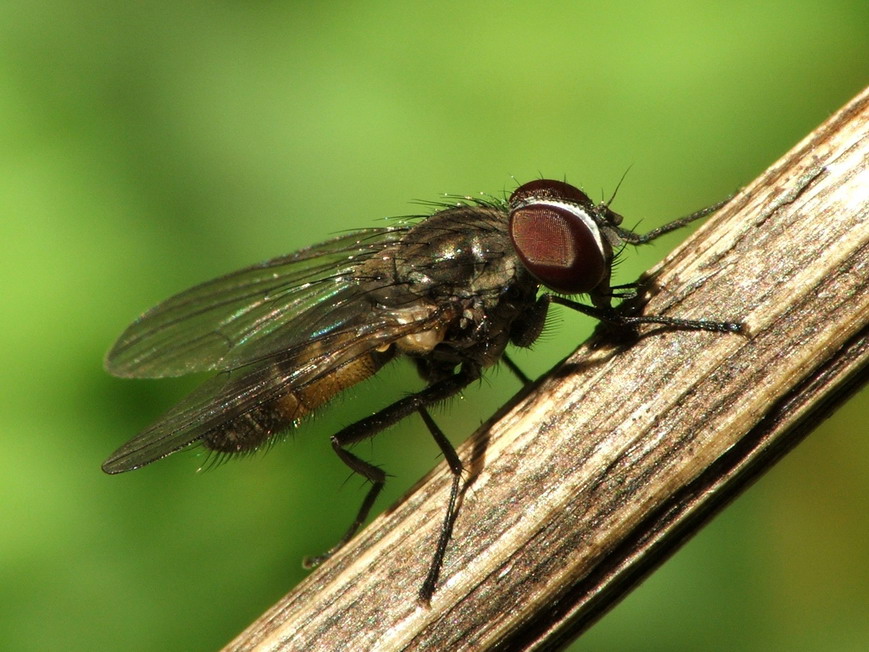- Fanniidae
image_caption = "Fannia canicularis "
regnum =Animal ia
phylum =Arthropod a
subphylum =Hexapoda
classis =Insect a
subclassis =Pterygota
infraclassis =Neoptera
superordo =Endopterygota |
ordo = Diptera
subordo =Brachycera
infraordo =Muscomorpha
zoosectio =Schizophora
zoosubsectio =Calyptratae
superfamilia =Muscoidea
familia = Fanniidae
subdivision_ranks = Genera
subdivision =
*"Euryomma "
*"Fannia"
*"Piezura "
*"Australofannia "The Fanniidae are a small (285 species in 4 genera) group of true flies largely confined to the Holarctic and temperate Neotropical regions.
There are 11 Afrotropical species, 29 Oriental, and 14 Australasian. See
Biogeographic Regions .Adults are medium-sized to small and usually have mainly dark body and leg colour. Males congregate in characteristic dancing swarms beneath trees; females are more retiring in habit.
Larva e are characterised by their flattened bodies with striking lateral protuberances, and live as scavengers in various kinds of decaying organic matter.Lesser housefly "Fannia canicularis" picture [http://www.ento.csiro.au/aicn/images/cain1807.jpg] This is a worldwide
synanthropic species.Other features are shown in this picture [http://delta-intkey.com/britin/images/colfann.jpg]Fannidae are indicators useful to forensic entomologists.Here is a picture of a muscoid fly maggot of the genus Fannia collected from a homicide victim during a murder investigation in northeastern
Ohio [http://inverts.cmnh.org/Web_images/lARVA4-2.jpg]Identifying characteristics for the family Fanniidae
The Fanniidae were once a sub-family of
Muscidae from which they may be distinguished by:A (strictly)dorsal bristle on the hind tibia below the middle and in addition to the dorsal preapical; axillary vein strongly curved towards the wingtip so as if extended the axillary and anal veins would meet before reaching the wing tip; in "males" middle tibia with erect pubescence beneath; in "females" frontalia without crossed bristles, frontal orbits broad, convex towards median line of
frons and with two pairs of strong upper orbital bristles, the anterior pair turned outwards.For a pictorial atlas explaining these terms go to [http://www.ento.csiro.au/biology/fly/fly.html#] and for images to the Diptera.info site [http://www.diptera.info/photogallery.php]Identification
*Chillcott, J.G. 1961. A revision of the Nearctic species of Fanniinae (Diptera: Muscidae). "Can. Entomol. Suppl". 14, 295 p. Keys to Nearctic genera and species. Excellent figures.
*Willi Hennig "Muscidae" inErwin Lindner : "Die Fliegen der Paläarktischen Region",7 (63b) 1-1110. Out of date. But good keys and figures.
*Lyneborg, L. 1970. Taxonomy of European "Fannia" larvae (Diptera, Fanniidae) "Stuttg. Beitr. Naturkd". 215, 28 p.pecies lists
* [http://www.nearctica.com/nomina/diptera/dipf-m.htm#anchor79297 Nearctic]
* [http://www.faunaeur.org/full_results.php?id=10914 West Palaearctic including Russia]
* [http://hbs.bishopmuseum.org/aocat/fanniidae.html Australasian/Oceanian]
* [http://konchudb.agr.agr.kyushu-u.ac.jp/mokuroku/ Japan]Other
Types in
Humboldt Museum , Berlin [http://www3.interscience.wiley.com/cgi-bin/abstract/112417954/ABSTRACT]External links
* [http://delta-intkey.com/britin/dip/www/fanniida.htm Family description and image]
Wikimedia Foundation. 2010.

